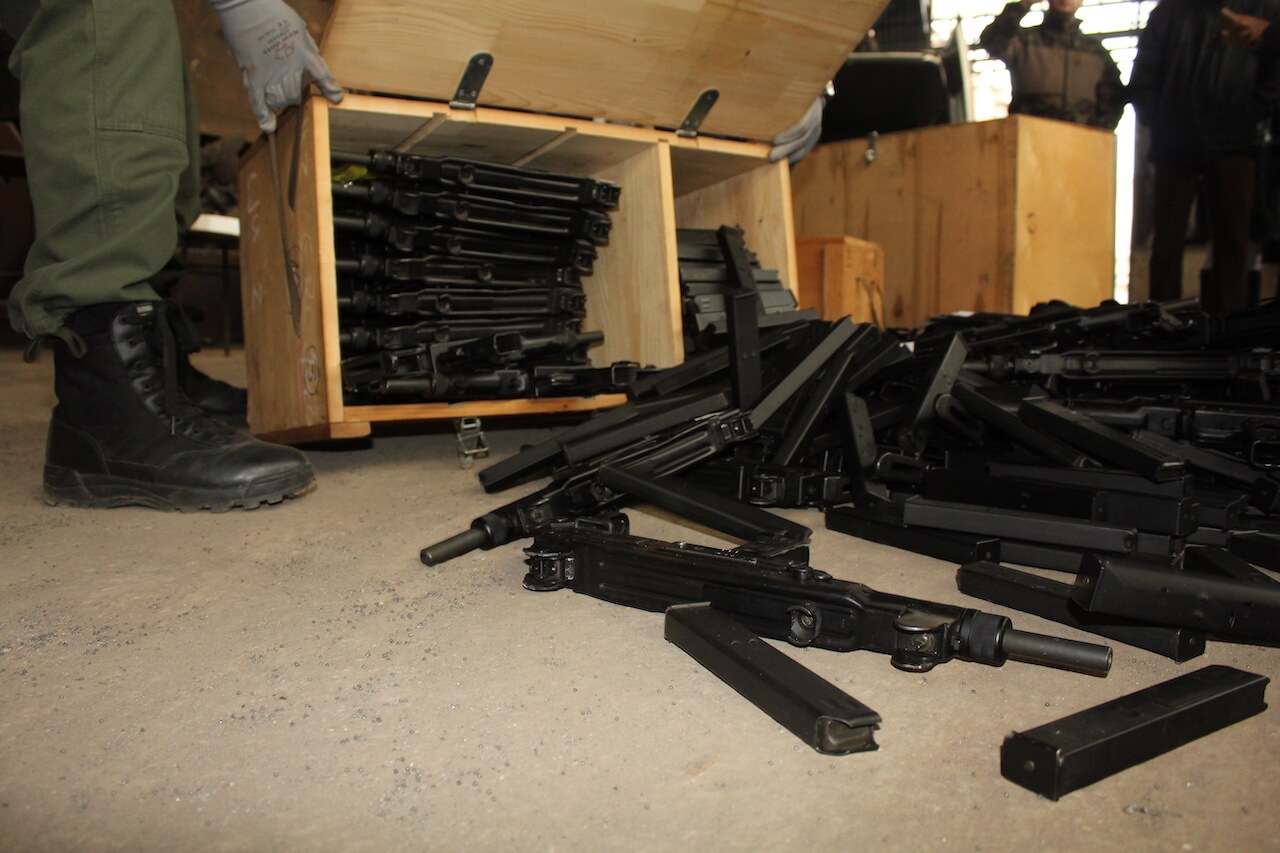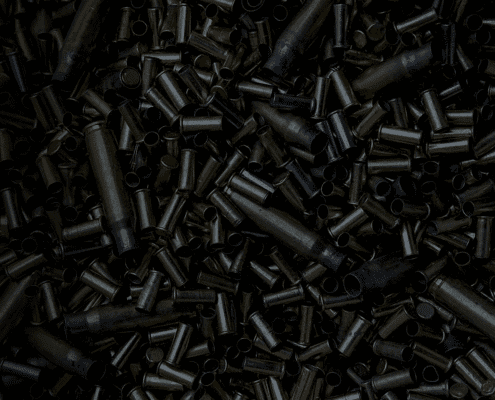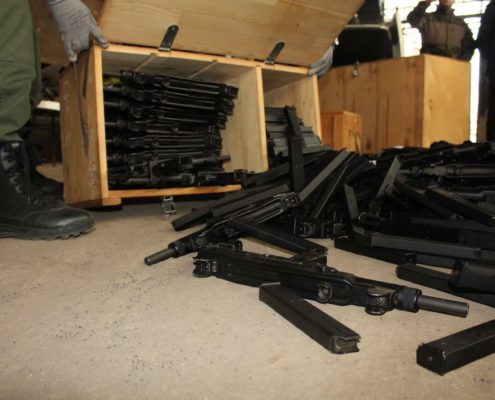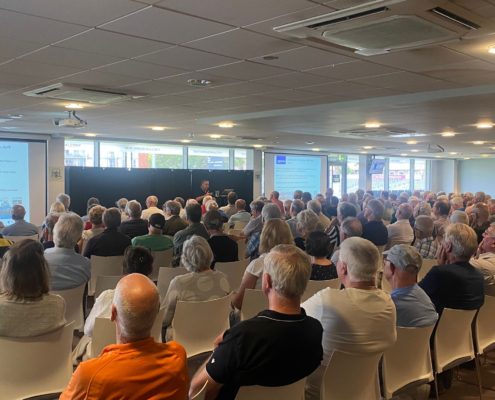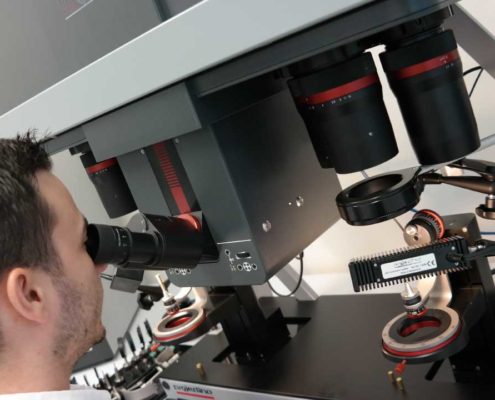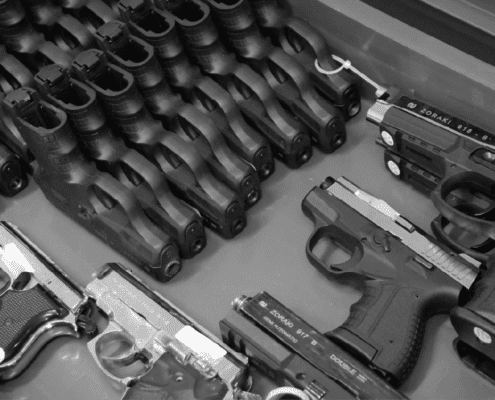 https://arquebus.uk/wp-content/uploads/2025/02/Picture-1-3.png
323
473
Rohan Harvey
https://arquebus.uk/wp-content/uploads/2022/02/Asset-1arquebus_logo.svg
Rohan Harvey2025-02-10 10:04:322025-02-10 15:23:07Arquebus Delivers Ballistic Examination Training in Montenegro
https://arquebus.uk/wp-content/uploads/2025/02/Picture-1-3.png
323
473
Rohan Harvey
https://arquebus.uk/wp-content/uploads/2022/02/Asset-1arquebus_logo.svg
Rohan Harvey2025-02-10 10:04:322025-02-10 15:23:07Arquebus Delivers Ballistic Examination Training in MontenegroBetween 1979 and 2021, there were 636 incidents of unplanned detonations at munitions sites, resulting in a total 30,883 casualties globally (Small Arms Survey, 2021). Ensuring the effective Physical Security and Stockpile Management (PSSM) of Small Arms, Light Weapons, and their ancillaries (ammunition, controlled accessories and essential components) (SALW), represents a vital step towards reducing the risk of both the unplanned detonation and diversion of SALW.
Arquebus is delighted to welcome Clinton Brunt, Technical Field Manager from the Mines Advisory Group (MAG) in Lebanon, to share his insights on PSSM and the role it plays in a National SALW Control Strategy (NSCS).
§
Insecure and poorly managed SALW stockpiles pose the dual threats of illicit proliferation and potential unplanned detonation. Inadequately secured SALW are targets for diversion by organised criminal groups and non-state armed groups, potentially resulting in destabilising effects upon national jurisdictions and wider regions. Equally, poorly handled, excessively accumulated and unserviceable SALW present an increased risk of unplanned detonations, representing a significant threat to public safety and the environment.
To help prevent illicit proliferation and unplanned detonation of SALW, governments must implement effective PSSM. PSSM refers to both the physical security of SALW stockpiles, including secure storage facilities, access controls and environmental conditions, as well as SALW inventory management, such as the regular auditing, record-keeping, and marking of SALW.
Robust procedures and oversight within a clear and well-defined framework, skilled and trained personnel, and innovative technologies all help to support the sustainability of PSSM measures over time. The use of internationally recognised technical data sources, such as UN hazard classification codes and compatibility groups, as well as adherence with relevant frameworks such as the International Ammunition Technical Guidelines (IATGs) and the UN Modular Small Arms Control Implementation Compendium (MOSAIC), also ensures that a jurisdiction’s PSSM is effective and in-line with good practice.
Arquebus is delighted to welcome Clinton Brunt, Technical Field Manager for MAG in Lebanon, to share his insights on PSSM, and the role it has in a NSCS.
§
Thank you for joining us, Clinton. Please could you introduce yourself and give our readers an outline of MAG’s work?
I’m an Australian, an ex-military Ammunition Technician, and in my current project we are providing safety storage assessments, advice, and training to Lebanon’s Armed Forces.
Whilst, as the name suggests, Mines Advisory Group’s primary focus has been on humanitarian de-mining, there has been a growing realisation of the wider scope of weapons proliferation. The use of weapons, abandoned munitions, and explosive remnants of war, all overlap in post-conflict zones. Reducing the risk of weapons proliferation and the consequences of unplanned explosions is all part of my field – weapons and ammunition management.
For example, in Lebanon we’re trying to help develop a national strategy to adapt weapons storage around the country so that stockpiles are not excessively loaded, secured appropriately and aren’t located in places that pose a risk to civilians, like towns and cities.
Broadly speaking, what are the key aspects of PSSM?
Literally as it says, ‘physical security’ is a combination of both keeping secure hold of weapons and ammunition. In Lebanon, for example, this involves improving the physical safety and security standards of the Lebanese military’s ammunition storages. This ranges from minor security upgrades to doors and locks, to constructing large-scale facilities to modern safety standards to replace facilities that are almost a century old, as well as assisting with the disposal of stocks of obsolete ammunition.
‘Stockpile management’ is managing the most efficient safe quantities – holding only the quantities necessary for the task. This ranges from a local police station with only a few traffic cops who only needs a small number of pistols, not a SWAT-tier arsenal that they aren’t trained to use effectively but still need to account for regularly. At a national level, stockpile management can be militaries disposing of storehouses full of obsolete ammunition when the guns are no longer in service. This is both to free up available space, but also to reduce the risk of it corroding and degrading over time until it explodes, causing civilian casualties.
PSSM also includes providing safety training for individual soldiers and storemen who are managing these kinds of facilities so that the simple little mistakes don’t result in an unplanned explosion, as well as putting in place policy that safeguards the integrity of weapons and ammunition stockpiles.
All these measures are aimed at increasing security and reducing the occurrence of an unplanned explosion in these facilities, which would have catastrophic consequences for a country.
What are the considerations for the safe and secure storage of SALW and their ancillaries?
Firstly, the emphasis of PSSM measures should be on SALW themselves. As SALW are small in size and highly mobile, combined with being highly attractive to being misused, their security is paradoxically of greater importance than assets normally seen as ‘high value’. The likelihood that an expensive Field Howitzer will be stolen and used in a robbery or homicide is much less than a smaller, less expensive pistol or rifle that can be smuggled away in a pocket or carry-bag.
Securely storing and managing SALW accessories is another important consideration of PSSM. Things like night vison gear or optical sights can be incredibly valuable, often more so than the weapons themselves. Also, militaries don’t want to risk ancillaries being diverted and potentially giving insurgent groups a technical advantage. Part of the battle is getting across the message you need to have a look at the physical security and management of beyond just the things that go ‘bang’.
Another factor is balancing the military or police requirement for rapid access and deployment with a system of accounting and physical access control that is reliable and robust. This is especially the case for smaller, unit-level armouries. If the armoury process is too time-consuming, members will revert to storing their ‘ready access’ firearms in their desk drawers or barracks rooms for convenience over security.
For bigger national weapon and ammunition stockpiles, it’s a different story – you have the time and resources to use more involved management techniques and implement further physical security measures. This includes more complicated tasks like stock rotation and auditing – bringing stock in, inspecting it, storing it, issuing it out, and bringing it back in. Also, surveillance and access controls typically go beyond what you would see at a unit-level.
In your experience, what are the most common quick wins that could be implemented to improve the PSSM of SALW?
This is important as military bases and armouries are often set up in strategic locations, in close proximity to a “hotspot” where soldiers might need to be deployed. This means PSSM measures need to be adaptable to environments that aren’t necessarily purpose built, like a football stadium or a disused factory.
In providing physical storage security, we focus on things like managing an individual’s locked storage and giving them proper padlocks with protective shields. Armouries constructed in ISO Containers are also a quick deliverable – racking welded to the inside of the frame, a pre-made lockable door and a counter panel fitted just inside. Whilst these aren’t ‘Fort Knox’-tier security, they can be assembled quickly and delivered to sites on a standard truck.
When managing stockpiles, we even use even simple things like $10 humidity metres in a storage area just to see what kind of environmental conditions ammunition is being exposed to, and then put in measures to reduce the risk of degradation. This might include things like better drainage or waterproofing – quick wins that can make all the difference.
For inventory management, unit numbers are a simple expedient that works on multiple levels. Marking every rifle with a number 1-100 on the butt in a distinctive colour for each sub-unit acts as a simple way to rapidly conduct a check that every rifle is in its correct rack. This has the benefit of checking that a soldier isn’t making-off with a rifle from another sub-unit to cover the absence of his numbered rifle, as well as acting as a strong psychological deterrent on theft.
In control of issuing weapons in and out, unit numbers make checking swift and easy, so it will be done every time and not neglected. The laborious checking of stamped serial numbers then only need be done at intervals, or when a damaged rifle is removed from a unit for disposal or repair and replaced.
How do you ensure the sustainability of PSSM for SALW over time?
As mentioned, the prime factor for sustained success in PSSM is a system that balances robustness of control with convenient rapid use. During emergency military deployments or at regular police shift-changes, the finest PSSM system will simply be ignored – we can modify security protocols but not human nature. By making the system simple and easy at the user level, when there’s an emergency and personnel need their weapons quickly, the armourer can count off how many have gone out, and then count them all back in again.
To ensure the sustainability of PSSM, you’ve also got to train and incentivise. Providing a basic ammunition and weapons course to teach armourers how to secure and manage their stockpiles can go a long way. These courses include the likes of regular auditing and recording the serial numbers of weapons in their inventory, but also getting them to understand why the process is important.
In Lebanon, we’ve been taking UN PSSM courses and translating them into Arabic, bringing out the technical skills of Lebanese military personnel by getting them to deliver the courses in their own language. In this one instance, one of my local staff delivering a lesson in Arabic got called away to a family emergency halfway through a lesson. I thought I’d have to change the slides over to English and find an interpreter, but before I could a young corporal stepped up and went “I can teach this, I understand it all” – it was a beautiful moment, and showed that what we were teaching about PSSM was really getting through.
What sources of good practice and guidance regarding PSSM are available to practitioners?
My recommendation for most readily available guide on PSSM would be the “PSSM Practitioners Handbook” available on-line at Regional Centre for Small Arms and Light Weapons (RECSA). While there are a lot of more scholarly articles on the topic available through the likes of the UN and Small Arms Survey, it’s always easier to start with the simple practical information and easily achieved physical works, and then work upwards from there.
What role does PSSM play in a NSCS?
As militaries and police services are the primary holders of large numbers of SALW, effective PSSM of their bulk SALW stockpiles is a major step in reducing the uncontrolled diversion to illicit usage and is the most effective starting point for any NSCS.
Armoury protocols preventing off-duty members having uncontrolled access to their duty firearms not only reduces inadvertent theft and misuse, but it also reduces instances of semi-official intimidation and corruption, and use of misused SALW in armed sexual assaults and domestic violence, and even alter the overall relationship between a community and its military and police.
§
In summary, this blog post and Q&A has considered the ways in which effective PSSM measures can support an NSCS, in addition to discussing the key aspects of PSSM that can help jurisdictions reduce the risk of SALW diversion, subsequent illicit proliferation and misuse, unplanned detonation.
In next month’s blog, the NSCS series shifts its focus to the role that SALW collection and destruction can play in an effective NSCS.
